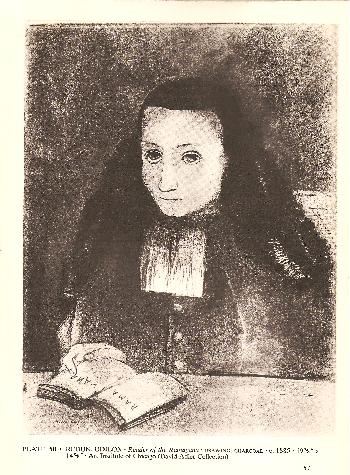The Srimad Valmiki Ramayan

(two lithographs by [Odilon Redon] on successive pages of "Modern Prints and Drawings" by Paul J. Sacahs; w/a bit of help from Alfred H. Barr, Jr)
Ramayan
(main stuff) BEGIN BLOCK QUOTE ================================================ Srimad Valmiki Ramayana is an epic poem of India which narrates the journey of Virtue to annihilate vice. Sri Rama is the Hero and aayana His journey. We in India believe that Sri Rama lived in Treta Yug, millennia BC and we are presently concerned with what Srimad Valmiki Ramayana tells us, rather than when it was told. This epic poem Ramayana is a smriti which is translated as "from memory". Given the antiquity of Srimad Valmiki Ramayana, there have been some interjected verses. Sometimes these verses can be contradicting. However, scholars, grammarians, historians have put lot of effort to standardize the original text, by verifying various manuscripts available from various parts of India, thus trying to stabilize and save the text from further contradictions. An example of this effort is the critical edition of Srimad Valmiki Ramayana. This site aims to study various versions of Srimad Valmiki Ramayana and arrive at a version of Ramayana that is most relevant to modern times. Srimad Valmiki Ramayana is composed of verses called Sloka, in Sanskrit language, which is an ancient language from India and a complex meter called -[Anustup. ]- These verses are grouped into individual chapters called Sargas, wherein a specific event or intent is told. These chapters or sargas are grouped into books called Kaandas where Kaanda means the inter-node stem of sugar cane, or also a particular phase of the story or an event in the course of story telling. Thus the structure of Srimad Valmiki Ramayana is arranged into six Kaandas or Books, and they are: Bala Kanda ( Book of Youth) [77 chapters] Ayodhya Kanda (Book of Ayodhya) [119 chapters] Aranya Kanda (Book of Forest ) [75 chapters] Kishkindha Kanda (The Empire of Holy Monkeys) [67 chapters] Sundara Kanda ( Book of Beauty ) [68 chapters] Yuddha Kanda ( Book of War ) [131 chapters] While stabilizing the original text of Ramayana, historians surmised that portions of two Books [Kaandas], namely Book I, Bala Kaanda and Book VII, Uttara Ramayana (not listed above) are later additions - "The first and the last Books of the Ramayana are later additions. The bulk, consisting of Books II--VI, represents Rama as an ideal hero. In Books I and VII, however Rama is made an avatara or incarnation of Vishnu, and the epic poem is transformed into a Vaishnava text. The reference to the Greeks, Parthians, and Sakas show that these Books cannot be earlier than the second century B.C......" quoted src: [ The cultural Heritage of India, Vol. IV, The Religions, The Ramakrishna Mission, Institute of Culture ].Ramayan
(continued)... [Following historical stabilisation (ie, sorting thru various versions/revisions/acretions) of the text]... However Book I, Balakanda is considered to be an original version except for some injected stories. Story starts from the fifth chapter of Book I, and tradition demands it to be read with the others. This stipulation is not obligatory to Uttara Kaanda, a later kaanda, wherein Sita's expulsion to forest takes place. Theologists worship Sri Rama as a God incarnate, philosophers make him the philosophical Absolute, while at the same time, materialists, condemning the above, appreciate the lyrical values of Ramayana, but as a great devotee-singer said "Whoever calls you in whatever way, you are that One". Ramayana contains 24,000 verses [sloka] arranged into numerous cantos [sarga] which are contained in 6 books as mentioned earlier. Each chapter, sarga, will be given briefly in english prose at its start and each verse will be rendered into Anglo-Sanskrit transliteration using ITRANS transliteration scheme developed by Avinash Chopde. A table mapping Romanized Sanskrit and ITRANS is also available at Avinash Chopde's web site. Each verse will be followed by the Word by Word meaning followed by its gist and explained based on theism, culture, literature as appropriate. The numbering of each verse will be in the format Book-Canto-Verse. We are also providing Verses in Devanagari and Roman fonts for easier readability. These true-type fonts have been developed by Omkarananda Ashram, Himalayas. The authors would like to express their deep gratitude and appreciation to Omkarananda Ashram for coming up with these beautiful fonts and also to Avinash Chopde for developing ITRANS scheme. This Valmiki Ramayana in Sanskrit is being translated and presented by Sri Desiraju Hanumanta Rao (Bala, Aranya and Kishkindha Kanda ) and Sri K. M. K. Murthy (Ayodhya and Yuddha Kanda) with contributions from Durga Naaga Devi and Vaasudeva Kishore (Sundara Kanda); Smt. Desiraju Kumari; Smt. K. Rajeswari, with all nthusiasm and devotion to classical literature of India, with humble and due respect to elders, pundits and to all those who respect Srimad Valmiki Ramayana the epic poem. aapadaam apahartaaram daataaram sarvasaMpadaam.h . lokaabhiraamam shriiraamam bhuuyo bhuuyo namaamyaham.h .. "I bow again and again to Sree Rama who removes (all) obstacles and grants all wealth and pleases all. " This is a salutation offered at the start of reading any scripture as per tradition. This prayer is for removing all obstacles encountered. The prefix Sri to Rama indicates that Rama is always accompanied by Sri, His consort Seetha in the form of goddess Sri Maha Lakshmi. [beauty, beauty-squared!]